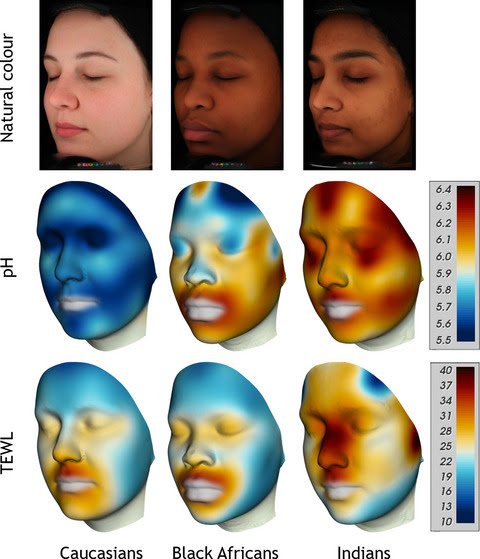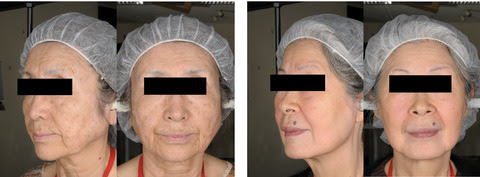| Cosmetic Science Volume 41, Issue 5Pages: i-iv, 411-515 October 2019 |
Issue Information
Review Article
 Open Access
Open Access
 Original Articles
Original Articles








Review Article
 Open Access
Open AccessFacial skin mapping: from single point bio‐instrumental evaluation to continuous visualization of skin hydration, barrier function, skin surface pH, and sebum in different ethnic skin types
R. Voegeli, J. Gierschendorf, B. Summers, A. V. Rawlings
Pages: 411-424 | First Published: 20 July 2019

The skin mapping technology enables the transformation of bio‐instrumental data to continuous 2D and 3D visualisation of facial skin features. This approach reveals the complexity of facial skin and the differences of differently pigmented skin types.
Clinical impacts of sun exposures on the faces and hands of Japanese women of different ages
F. Flament, D. Velleman, S. Yamamoto, A. Nicolas, K. Udodaira, S. Yamamoto, C. Morimoto, S. Belkebla, C. Negre, C. Delaunay
Pages: 425-436 | First Published: 17 July 2019

Illustrative examples of sun exposures’ clinical impact on NSP (left) and SP (right) on two pictures (Front‐full face and 45° lateral). Both subjects are of same age (71 years old).
Synchronized in vivo measurements of skin hydration and trans‐epidermal water loss. Exploring their mutual influences
E. Caberlotto, C. Cornillon, S. Njikeu, M. Monot, M. Vicic, F. Flament
Pages: 437-442 | First Published: 16 July 2019

Illustrations of the GPSkin Barrier probe from different views. The two yellow circles represent the surface hydration sensors; the black square is the RH% sensor located at the bottom of the chamber.
Morphometric characteristics of feminine eyebrows: variations with ethnicities and age
F. Flament, I. Seyrek, G. Francois, T. Zhu, C. Ye, D. Saint‐Leger
Pages: 443-449 | First Published: 16 July 2019

(up) and (down): schematic illustrations of the adopted markings of both eyebrows, symbolized by theoretical triangles (down). M and M’ refer to the total hairy area of the eyebrows (i.e. their magnitudes).
Assessing the impact of an aerial chronic urban pollution (UP) on some facial signs of differently‐aged Chinese men
F. Flament, C. Ye, D. Amar
Pages: 450-461 | First Published: 16 July 2019

Examples of average grading of 3 facial signs (wrinkles and skin texture) in HP and LP cities, in the same 40–49 years group.
Engineering optimisation of commercial facemask formulations capable of improving skin moisturisation
P. Mehta, H. Picken, C. White, K. Howarth, K. Langridge, K. Nazari, P. Taylor, O. Qutachi, M.‐w. Chang, Z. Ahmad
Pages: 462-471 | First Published: 18 July 2019
An automatic procedure that grades some facial skin structural signs: agreements and validation with clinical assessments made by dermatologists
F. Flament, M. Hofmann, E. Roo, C. Raimbault‐Gerard, B. Chuberre, Y. Zhang, R. Jiang, I. Kezele, J. Zhang, E. Elmozino, J. Coquide, V. Arcin, P. Aarabi
Pages: 472-478 | First Published: 24 July 2019

Description of all data and images collection and their subsequent analysis on a 42 years old Spanish woman.
Characterization and topical delivery of phenylethyl resorcinol
Y. Zhang, B. C. Sil, C.‐P. Kung, J. Hadgraft, M. Heinrich, B. Sinko, M. E. Lane
Pages: 479-488 | First Published: 04 August 2019

The physicochemical properties of a novel skin lightening ingredient, phenylethyl resorcinol (PR), has been systematically characterized for the first time. The permeation behavior of PR was evaluated in porcine and human skin under finite dose conditions.
Increase in subjective well‐being and psychological health after application of C8‐silk lipoamino acid functionalized pigments included in a foundation
M. Cabannes, C. Risselada, L. Chaisemartin, J. Pasquet, E. Couval, J.Y. Berthon, E. Filaire
Pages: 489-495 | First Published: 06 August 2019

Beauty will globalize well‐being. Women expect from cosmetics is emotional pleasure, sensoriality for improving well‐being with new and smart cosmetic products. The objective of this study was to evaluate the use of two foundations on psycho‐physiological parameters and their cosmetic benefits in order to highlight the interest of a C8‐silk lipoamino acid silk as pigment functionalisation agent versus untreated pigments. Foundation used during 5 days can increase subjective well‐being as well as physiological health by decreasing the concentration of the stress‐related hormone cortisol.
Bioactive compounds sourced from Terminalia spp. in bacterial malodour prevention: an effective alternative to chemical additives
I.E. Cock, M.H. Wright, B. Matthews, A. White
Pages: 496-508 | First Published: 05 August 2019
Age, lifestyle and self‐perceptions of hair: Is there an association with hair diameter and tensile properties?
L. Duvel, A. Herbal, L. Daniels, R. Kong, G.G. Hillebrand
Pages: 509-515 | First Published: 16 August 2019

The biophysical properties of hair change significantly with age. A history of smoking or being overweight was significantly associated with having smaller hair cross‐sectional area but was not associated with differences in hair tensile properties. The self‐perception of having strong or healthy hair seems more associated with having a larger cross‐sectional area than any real differences in hair strength.

Δεν υπάρχουν σχόλια:
Δημοσίευση σχολίου